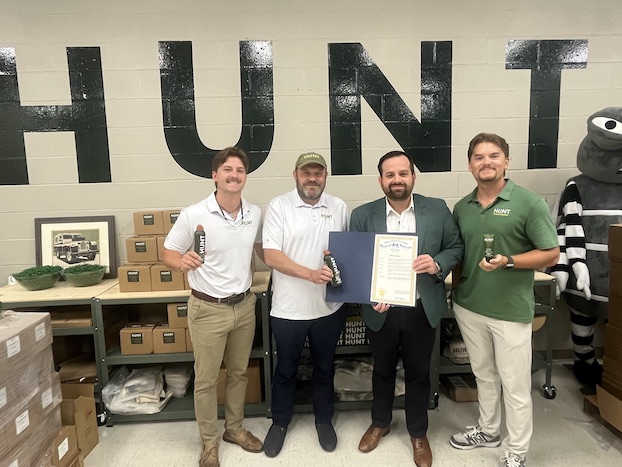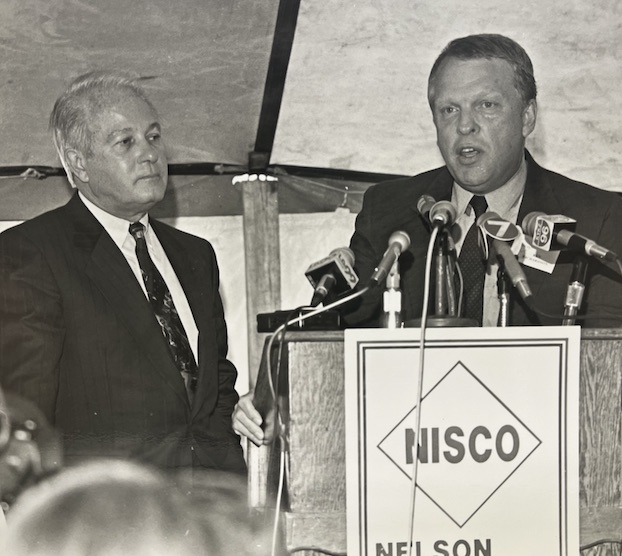Hiking through Burgundy
Published 6:32 pm Friday, August 18, 2017
Entire countryside unites for annual grape festival
Mary Richardson / Special to American Press
PART I: THE HIKE
There were red grapes
to the left of me, green
grapes to the right, and
here I was, walking in the middle with Joe.
We were on a seven-day hiking trip in the Côte de Beaune, the southern half of the Côte d’Or, which is in the middle of the famed Burgundy wine region. We had arranged the hike through Sherpa Expeditions, a company based in London that provided trail notes, arranged lodging, and, most importantly, transported our luggage each day to our next destination.
Trending
The day was bucolic. We had needed jackets in the cool morning, but soon shed them as the sun rose in a perfect blue sky. Large muscled white cows, the famed bred-for-beef Charolais, mooed at us. Bees buzzed. There were field after field of grape vines, all planted in straight rows situated to get every possible ray of sunshine.
“This couldn’t be more pastoral,” I said to my husband, Joe. “Nature is in balance. It is totally peaceful.”
I was wrong.
Unbeknownst to me, the annual grape harvest — the Vendanges — had begun. It lasts about a month and it is characterized by utter madness. Running replaces walking. Intensity replaces calmness. The whole countryside unites in a single purpose — harvesting grapes and turning them into wine. Quickly. Urgently.
But I didn’t know that yet.
All I saw were grapes. I wanted to taste them. “I’m going to duck into this row for a minute,” I told Joe. “Don’t you pick those grapes!” he responded. “The farmers would not appreciate that.”
Only two types of grapes are grown here, the green chardonnay and the purple pinot noir. I popped a single chardonnay grape in my mouth, chewed it up and spit out skin and seeds. The grape had structure. I’ve heard a lot about the “structure” of wine but I never understood it until I was chewing up a chardonnay.
I crossed the path to the pinot noir vines. Totally different. The skin was so delicate it broke in my fingers. A single drop of pure, purple, fruity juice jumped in my mouth. An image of pinot grapes all wearing little French maid aprons and dancing a cancan flashed into my mind. These grapes were sassy.
I picked the most perfect specimens and offered them to Joe. He nervously turned up his nose so I ate them as we entered the village of Meursault, where we would spend the night.
DETOUR FROM VINEYARDS
The next day we temporarily left the world of wine. We climbed the rough and stony escarpment surrounding Meursault and entered a forest that our trail notes said was full of remains from pre-historic settlements and Gallo-Roman ruins. We found the little village of Saint-Romain. The village has two parts — one on top of the cliffs and one below, and settlements have been here, practically without interruption, for the last 6,000 years.
In the high village, St. Romain-le-Haut, we walked into the simple 11th century church and walked through the ruins of an old chateau. Then we stood on the limestone cliff and read our trail notes: “Very nice for the wild flowers, and people go up there to commit suicide. Brothers, sisters, mothers, and fathers.” We carefully followed the narrow path to the lower village, St. Romain-le-Bas.
The population of Saint-Romain used to be larger. Around 850 people lived in the village before the two world wars. Now the population is less than 200 people. We found one of the ubiquitous stone crosses that mark the Burgundian countryside and villages. These always list the young men who died in WWI, although some include WWII. The one in the village of Rully includes those who were “arretes par la Gestapo” and who died in the “guerre d’algerie.”
In the following days, Joe started counting the number of people inscribed on these crosses who died during WWI, and that is how we started to comprehend the toll of that war. “Twenty young men in this village of 200 people?” he said. “And that’s only one of the wars. What a loss!”
We spent the next several days hiking up and down several ranges of hills. We crossed the Canal du Centre, climbed goat trails, and walked the broad paths on top of the limestone cliffs. Part of the time we were following the Route des Grands Crus. But by nightfall, we always ended up in villages with their own distinctive wines — which we paired with regional dishes like coq-au-vin and an amazing variety of fresh cheeses. (Charles De Gaulle once asked “How can you govern a country which has 246 varieties of cheese?”)
GRAPE PICKERS UNITE
The vineyards were being transformed day by day. They were no longer peaceful! Teams of grape pickers had arrived from Eastern Europe and Northern Africa. The pickers had been transported into the fields by so many white Renault vans that from a distance the hills looked like they were wearing strands of pearls. The pickers bopped up and down in the rows as they filled their buckets. When full, they poured their grapes into backbaskets — big triangular baskets men wore on their backs. Those men hefted the 110-pound or so loads to waiting trucks. Then they ran back for more grapes.
When the church bells rang at noon, everything stopped. The vineyards were peaceful again as the pickers took naps wherever they were. Some laid down under trees, some curled up between the rows of grapevines. I tried to muffle the sound of my hiking boots so I wouldn’t wake them. Then the church bells struck 1 p.m. and labor resumed.
We entered the village of Rully and received another surprise. Only a few days earlier, gates and doors to the courtyards of the houses had been shut tight. Now every gate was wide open. Trucks full of grapes from the vineyards were being unloaded into destemmers which spit out the branches and stems. The remaining skins, seeds and juice were transported up conveyer belts and into holding tanks. No one had wine yet — they had grape juice. This first step in the wine-making process was taking place everywhere.
COURTYARD CLOSEUP
No one seemed to mind my staring into their courtyards. That’s how I met my first wine grower, Patrick Duvernay, owner and winemaker of the Domaine de la Renaissance. He not only said I could take pictures but offered me a glass of chardonnay grape juice, straight from his press. Only a few hours (maybe minutes) before, that juice had been grapes ripening in the warm French sunlight.
Patrick’s wife, Sophie, told me their history. Patrick had been born into a wine-making family but, in 2008, the two of them made the huge decision to buy their own domain.
They named it Renaissance because, “it was like being born a second time,” Sophie said. “For my husband, it marked the separation from his family, and it was a new beginning for us.”
As is the case for almost all domains, their vineyards are spread throughout the region. Because of the aftermath of the French Revolution and French inheritance laws, plots have become smaller and smaller; sometimes they consist of only a few rows in a large field. So the Renaissance Domaine has plots in many areas, places we had walked through — Rully, Mercurey, Bouzeron, Pommard and more. If patched together, they would total 16 hectares, about 37 acres.
Sophie and Patrick bottle 30,000 bottles of wine a year — but that is only a small portion of their production. The rest of the juice they sell. They do not export. All 30,000 bottles go to restaurants and clientele. Unlike prices for Premier (lst cru) wines in the states, the wines are not expensive at the domaine. Sophie sells their very best wines for 17 euros and their still delicious but not Premier cru wines for only 10 euros. (After returning to Lake Charles, I found a wine similar to theirs for $110!)
While Sophie and I were talking down in their cool, brick lined cellar, Patrick was above us in the courtyard processing the grapes. “He does everything,” Sophie said. “He plants the vines, he makes the wine — it’s all him. He never rests.”
I told her about my first impression of Burgundy when we walked through the high pastures with the mooing cows and the buzzing bees and my feeling of utter peacefulness as we descended into the vineyards. I expected her to laugh. Instead, she almost cried.
“I love to see these vineyards through your eyes,” she said. “It resonates with me. I am so glad you had a chance to see that.” As for her life with Patrick, “We never have a holiday,” she said. “It is all travail, all work.”
PART II: THE WINE
We ended our hiking trip when we walked back to Beaune. There we rented a Citroen and drove to Pommard, located just a few miles to the south. We had rented an apartment there through Airbnb.
Pommard is a picture-perfect village dominated by an 18th century church with a square tower. Whereas most small towns in the United States have a 7-11, a Dollar General, a grocery store, several gas stations, and a bank, Pommard has none of these. What it does have is a boucherie for meats and pate, a boulangerie for bread, a patisserie for pastries, a shop for only chocolate — and dozens of Caves (cellars) for tastings and sales of some of the highest regarded wines made in Burgundy.
Around 500 people live in Pommard and 40 families are involved in wine. Because it was the middle of harvest, the narrow streets were filled with farm machinery, ducking in and out of 17th and 18th century buildings.
To our good fortune, our Airbnb host, Fabienne, was married to Olivier Cyrot — renowned wine maker, owner and propriétaire récoltante (grower of grapes) of the Cyrot-Buthiau Domaine.
Olivier was up at dawn waiting for the grapes to come in, then working until dusk getting those grapes processed. His harvest would be over in a few days, but then his work as wine maker would begin. He would transform his juice into award-winning wines.
WINE TASTING
One Saturday night he took time off and invited us down to his beautiful wine cellar to taste his wines. All the domaines have wine cellars, usually dating to the 1700s or older. The Cyrots have two. The one we were in was used to store the wines they sell. There is also a family cellar. According to tradition, family cellars contain wines made in the year of a child’s or grandchild’s birth, or wines from the year of a marriage. Sometimes there is still wine from World War II when the men were away fighting; it fell to the women to keep the vineyards alive and make the wine. The Cyrots’ family cellar has wine made in 1945 by Olivier’s grandmother.
Olivier is a fourth-generation winemaker, but his destiny as a winemaker was not assured. His father died when he was only 13 — too young to take over the domaine. For many years the fields were lent to other growers. It could have been the end of Cyrot-Buthiau wines, but family members from another domaine took Olivier under their wing. He went to viticulture school and at the age of 18 he took control of the Cyrot domain.
He made his first wine in 1989. But he couldn’t sell it until it had aged, and that wasn’t until 1991. “It was hard,” said Fabienne. “We had nothing, no clientele, no prospects.” They persevered and they succeeded.
Today, the domaine produces 40,000 bottles a year on about 17 acres of land. Three of the vineyards are Premier, 1st Cru. Olivier has won many awards and the domaine was just featured in an issue of the magazine Wine Spectator. They export about half of their wines (but none to Louisiana or Texas).
Not that their success has been easy. The weather over the past five years has been horrible for wine production. Growers watched helplessly as frost, excessive rain, hail, and humidity decimated their crops. This year looked promising. Then, in April a frost killed 60 percent of the buds. “After that, the sun came out and we had a great summer,” Fabienne said, “but the damage was done.”
In their cellar, Olivier poured samples of his many wines. Then he brought out one of his favorites — a rich, smooth, elegant pinot noir from 2012 he had named L’Exception. The wine showed his prowess as a wine maker, because 2012 was a very bad year for growing grapes. The yield from all three of his Premier Cru fields could hardly fill one oak barrel. So he carefully combined them. On the label he gave credit to all three fields — Les Charmots, Les Arvelets (his favorite), and La Chaniere. He named the wine L’Exception because he hoped he would never need to make it again.
But now he’s considering. “It’s looking like there may be two vintages of L’Exception — a 2012 and a 2016,” Fabienne said. “The grapes are fantastic this year, but so few …”
PERSONAL TERROIR
As the night progressed, we again heard a special word — terroir. The word describes the land, but it means more. Terroir encompasses the consistency of the soil and whether the soil is primarily clay or limestone. It means how the slope is situated toward the sun so the grapes can receive the maximum minutes of sunshine every day. It describes the soul of the field. The very specific conditions of each terroir impart taste and flavor to the grapes.
When I asked people which was more important, the terroir or the skill of the winemaker, they wavered. It seemed to be a chicken/egg question. I thought that Olivier, since he is a winemaker, might be inclined to say the winemaker is the most important. He did not.
Instead he said it was his duty to understand the terroir of each of his fields. He has a goal — he wants to create fine and elegant wines. “Not strong or thick,” he said. “Not rustic.” And how does he do that? “By understanding the terroir.”
As I looked at the light honey-colored chardonnay and the luminous purple of the pinot noir, I knew I could never properly describe these wines. I would leave it to others to talk about the tannins, the legginess, the body profile, the dryness, the sweetness.
I would just remember this moment as a kind of personal terroir — the day I was in this particular part of France, in this particular cellar in this singular village, with these particular people surrounding me — and be grateful for it all. We raised our glasses and said Salute!
*This story first appeared in the American Press on October 23, 2016.
Men wear these cone-shaped baskets, called backbaskets, to collect grapes from the pickers in the field. They take the 110 (or so)-pound loads to the waiting trucks. (Mary Richardson/Special to the American Press)
When the grapes reach the their peak of ripeness, the Vendanges begins. Pickers come from all over, especially Eastern Europe and North Africa, and work in a frenzy of activity until eery grape has been harvested. (Mary Richardson/Special to the American Press)





